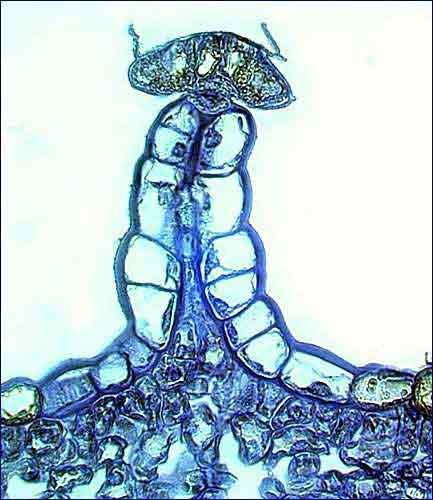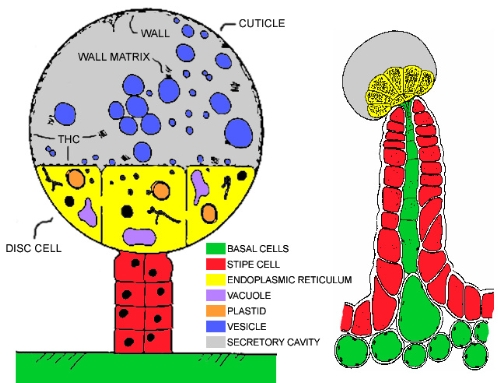


Trichomes
Trichomes are often considered to be the resin glands of the cannabis plant and determine the potency of the plant. The word Trichomes comes from Latin and means “growth of hair”, though in botany Trichomes are to be diverse structures, with assorted functions, and so can be hairs, glandular hairs, scales and even papillae on the plant. On the hemp plant, Trichomes come in three basic varieties. These are Bulbous, Capitate-Sessile and Capitate-Stalked.
Bulbous are the smallest type, at only 15-30 microns in size. They are considered to be responsible for secreting a resin of cannabinoids and other associated chemicals. They form a small tree-like structure, and during maturity form a papillae, or a nipple-like structure on the top, due to the pressure of resin being pushed out from lower parts of the bulbous. They are found scattered on all surfaces, which are above-ground.
Capitate-Sessile are the mid-sized type, at only 25-100 microns in size. Immature plants do not appear to have stalks, as the heads lie flush to the surface, and are specifically called capitate-sessile, but mature plants are known as capitate. Capitate means to be “globular shaped”, and the capitate heads are certainly that. A cannabinoids rich resin is secreted at the top of the capitate. This resin may be as high as 90% cannabinoids. Capitate are very numerous on all surfaces, which are above-ground.
Capitate-Stalked are the large type, at 150-500 microns in size, and consists of layers of secretory disc cells that give rise to the secretory cavity. The secretory cavity plays a major role in the production of primary and secondary products, such as cannabinoids, but its activities are not known, in either the cannabis plant or any other plant in nature. Capitate-Stalks will appear on female and male plants during growth, but are limited to size until flowering begins, when they will “bloom” and be at their largest. On the female plant, the capitate-stalks will appear on the flower bracts, and also in heavy concentrations on the small leaves that accompany the flowers. On male plants, the capitate-stalks are smaller and are fewer, than on their female counterparts. Though a large row will form on the anthers, or pollen-producing organs.
Trichomes are often considered to be the resin glands of the cannabis plant and determine the potency of the plant. The word Trichomes comes from Latin and means “growth of hair”, though in botany Trichomes are to be diverse structures, with assorted functions, and so can be hairs, glandular hairs, scales and even papillae on the plant. On the hemp plant, Trichomes come in three basic varieties. These are Bulbous, Capitate-Sessile and Capitate-Stalked.
Bulbous are the smallest type, at only 15-30 microns in size. They are considered to be responsible for secreting a resin of cannabinoids and other associated chemicals. They form a small tree-like structure, and during maturity form a papillae, or a nipple-like structure on the top, due to the pressure of resin being pushed out from lower parts of the bulbous. They are found scattered on all surfaces, which are above-ground.
Capitate-Sessile are the mid-sized type, at only 25-100 microns in size. Immature plants do not appear to have stalks, as the heads lie flush to the surface, and are specifically called capitate-sessile, but mature plants are known as capitate. Capitate means to be “globular shaped”, and the capitate heads are certainly that. A cannabinoids rich resin is secreted at the top of the capitate. This resin may be as high as 90% cannabinoids. Capitate are very numerous on all surfaces, which are above-ground.
Capitate-Stalked are the large type, at 150-500 microns in size, and consists of layers of secretory disc cells that give rise to the secretory cavity. The secretory cavity plays a major role in the production of primary and secondary products, such as cannabinoids, but its activities are not known, in either the cannabis plant or any other plant in nature. Capitate-Stalks will appear on female and male plants during growth, but are limited to size until flowering begins, when they will “bloom” and be at their largest. On the female plant, the capitate-stalks will appear on the flower bracts, and also in heavy concentrations on the small leaves that accompany the flowers. On male plants, the capitate-stalks are smaller and are fewer, than on their female counterparts. Though a large row will form on the anthers, or pollen-producing organs.



